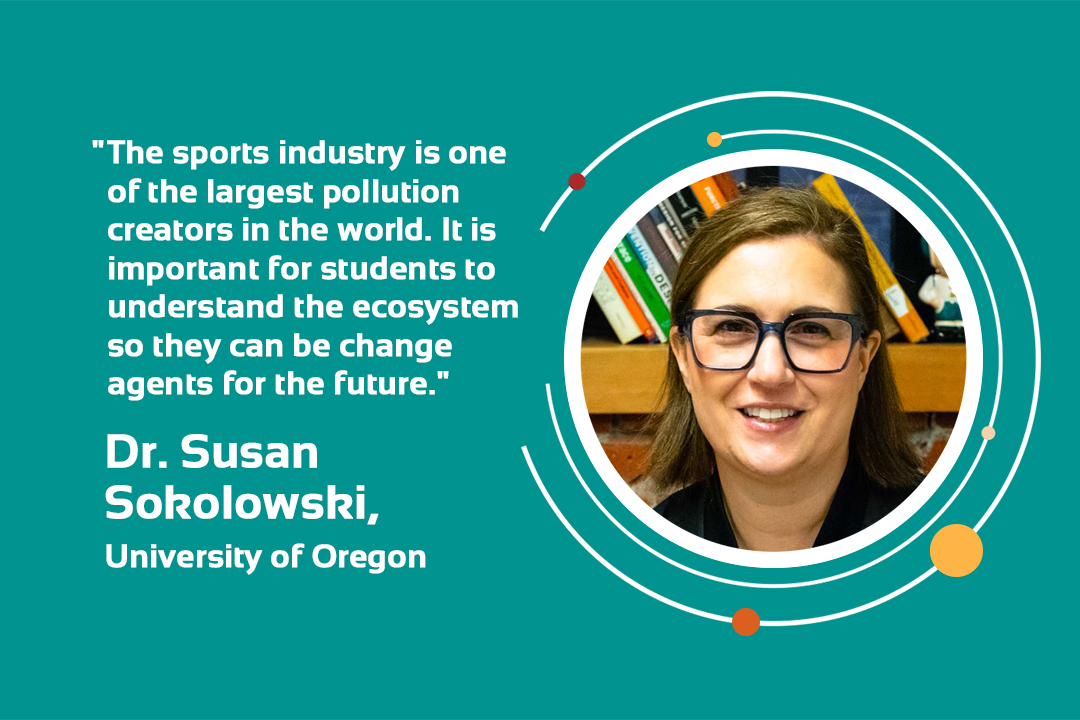
Our Faculty Spotlight series highlights educators within the VentureWell network who are doing transformative work—faculty members who are catalyzing change in higher education and inspiring students to impact the world through invention. This month’s spotlight is Dr. Susan Sokolowski, Director of Sports Product Design at the University of Oregon. She is dedicated to holistically integrating sustainable design principles into sports product design curriculum, preparing students to join the call to significantly reduce the sports industry’s environmental impact. Dr. Sokolowski received a VentureWell Faculty Grant (now called Course & Program Grants) in 2018 to develop new studio courses that provide graduate students with experiential learning opportunities, mentorship with experts in green design, and support for environmentally-conscious sports product design.
Tell us about your journey infusing entrepreneurship in your field and curriculum.
The mission of the Sports Product Design program is to develop graduates proficient in using theories and creative problem-solving methods to create innovative products that push the boundaries in sport and society. The program naturally inspires an entrepreneurial mindset, and our curriculum offers courses that enable students to hone their skills in research, problem identification, ideation, prototyping, materials, product development, and presenting.
Tell us about the courses you received a VentureWell Course and Programs grant for.
Following fossil fuels, the sports industry is one of the largest pollution creators in the world. This statement is quite ironic, as the sports industry is famous for its inventive products. Whether it is an aerodynamic track and field speed skin, an artificial limb for a disabled skier or a helmet for concussion protection, the industry sets a great example of how science, engineering, design, and business come together to make better performing products. When design educators teach students how to innovate new products for athletes, we have historically done so by focusing on improving athletic performance. Although the practice of sustainability has been part of the design process in the sports industry, it is shortsighted. It only focuses on materials selection — and that typically only means using recycled polyester. It does not fully consider sustainability practices related to water pollution/use, energy, sports marketing, advertising, ideation/creation, manufacturing/ production, shipping, retail, and producing major sport events. I think it is important for students to understand the ecosystem, so they can be change agents for the future.
How do you want the field of entrepreneurship to evolve in the next five years? What do you imagine your role will be in that work?
In the past it was much more difficult to be an entrepreneur in the sports product design industry because it was financially challenging to secure materials, factory space, and retail space. With the decline of brick-and-mortar retail and the increase of online sales, these barriers have diminished, opening opportunities for anyone with a great idea. Since our program started in 2016, we have had nine student startups funded and we believe those will continue to grow. We are here to support those students: to help them identify great opportunities, create innovative products, and secure funding.
What are the challenges you’re tackling in your work today, and how are you addressing them?
I am currently thinking about ways to create energizing social interactions inside and outside the classroom. The pandemic has been tough on students and educators. It is important that our learning environments continue to be inspiring, and students are engaged. Since we are teaching 100% in person this year, I am planning “sprint” projects with industry partners to bring real-life challenges to the classroom that can be completed in 2-3 weeks.
What media on entrepreneurship and innovation has had the greatest impact on you and your work, and how have they been insightful to you?
When I discovered Strengths Finder by Tom Rath as an innovator, it totally changed how I thought about my skills and how I looked for fulfilling work. I use this book each year with our new students to understand how I can support them and how they can collaborate with each other.
What’s your most useful classroom activity or assignment?
I love using the principle of the Medici Effect in the classroom. We worked on a project this summer where students created innovative new sport bags by looking at the principles of modern architecture. It was a great way to break the boundaries of inventing new products that have so many restraints, like a sports bag.
Tell us about a moment or experience that reaffirmed the importance and value of STEM entrepreneurship education for you.
The Sports Product Design program epitomizes STEM entrepreneurship education. What is important for us is that we share this knowledge with others that may be afraid of STEM education and demonstrate that a career in the sports industry can be fun and rewarding. Before the pandemic, we worked with at-risk girls in the Portland metro area on a project called “Stepping, Skipping and STEMming: Using the Power of Sport to Affect the Future Success of Middle and High School Girls.” As a first-generation college student, it is important for me to pay it forward to the next generation of girls that are looking to make a difference and go to college.